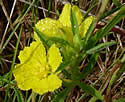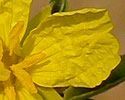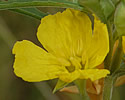Oenothera serrulata (Yellow Sundrops)
| Also known as: | Toothed Evening Primrose, Plains Yellow Primrose |
|---|---|
| Genus: | Oenothera |
| Family: | Onagraceae (Evening Primrose) |
| Life cycle: | perennial |
| Origin: | native |
| Habitat: | sun; dry sandy or rocky soil; prairies, rock outcrops, bluffs, dunes |
| Bloom season: | June - August |
| Plant height: | 1 to 2 feet |
| Wetland Indicator Status: | none |
| MN county distribution (click map to enlarge): |  |
| National distribution (click map to enlarge): |  |
Pick an image for a larger view. See the glossary for icon descriptions.
Detailed Information
Flower: 
![[photo of flower]](/udata/r9ndp23q/pd/calylophus-serrulatus-all-12-t.jpg) Single yellow flowers in the upper leaf axils with 4 rounded petals ¼ to ½ inch (5 to 12+ mm) long, often wrinkled like crumpled tissue paper, with wavy edges that are sometimes a bit ragged, and a rounded notch at the tip. In the center are 8 yellow stamens surrounding a stigma with 4 disc-shaped lobes. The 4 sepals are shorter than the petals, triangular to egg-shaped with a prominent mid-rib, and reflexed down at bloom time. Flowers are stalkless but sit on top of a hairy, cylindrical ovary about 3/8 inch long that resembles a stalk.
Single yellow flowers in the upper leaf axils with 4 rounded petals ¼ to ½ inch (5 to 12+ mm) long, often wrinkled like crumpled tissue paper, with wavy edges that are sometimes a bit ragged, and a rounded notch at the tip. In the center are 8 yellow stamens surrounding a stigma with 4 disc-shaped lobes. The 4 sepals are shorter than the petals, triangular to egg-shaped with a prominent mid-rib, and reflexed down at bloom time. Flowers are stalkless but sit on top of a hairy, cylindrical ovary about 3/8 inch long that resembles a stalk.
Leaves and stems: 

![[photo of leaves]](/udata/r9ndp23q/yellow/yellow-sundrops_0619_084104-t.jpg) Leaves are alternate, narrowly oblong, linear, or widest above the middle, ½ to 3½ inches (to 9 cm) long, up to 3/8 inch (1 cm) wide, stalkless or nearly so, short-hairy on the underside, usually with small, sharp teeth around the edges, occasionally toothless. Stems are ascending to erect, green to brown, covered in stiff, fine hairs, single or multiple from the base, unbranched or few-branched, and woody in the lower stem.
Leaves are alternate, narrowly oblong, linear, or widest above the middle, ½ to 3½ inches (to 9 cm) long, up to 3/8 inch (1 cm) wide, stalkless or nearly so, short-hairy on the underside, usually with small, sharp teeth around the edges, occasionally toothless. Stems are ascending to erect, green to brown, covered in stiff, fine hairs, single or multiple from the base, unbranched or few-branched, and woody in the lower stem.
Fruit: 
![[photo of fruit]](/udata/r9ndp23q/pd/calylophus-serrulatus-all-5-t.jpg) Fruit is a slender, cylindrical capsule in the leaf axils, slightly tapered at both ends, up to about 1 inch (6 to 25 mm) long, covered with fine, short hairs. Inside are numerous seeds, 1 to 1.8 mm long, sharply angled.
Fruit is a slender, cylindrical capsule in the leaf axils, slightly tapered at both ends, up to about 1 inch (6 to 25 mm) long, covered with fine, short hairs. Inside are numerous seeds, 1 to 1.8 mm long, sharply angled.
Notes:
Yellow Sundrops, also known as Calylophus serrulatus, is common in dry prairies and rock outcrops. It is typically much shorter than the tall spiked stems of evening primroses and has much narrower leaves. Another distinction with this species is that it blooms during the day where most Oenothera flowers open in afternoon or evening, for pollination by night-flying insects. It does great in a garden and has a fairly long bloom period. Personally, I was disappointed when the musical name Calylophus was dropped in favor of boring Oenothera, but at least it's in Oenothera subsection Calylophus.
Native Plant Nurseries, Restoration and Landscaping Services ↓
More photos
 Yellow Sundrops plants
Yellow Sundrops plants Yellow Sundrops plants in the grass
Yellow Sundrops plants in the grass Yellow Sundrops habitat
Yellow Sundrops habitat wrinkled flower petals
wrinkled flower petals more flowers
more flowers
Photos by K. Chayka Ramsey and Washington counties. Photos by Peter M. Dziuk taken in Dakota and Pope counties.
Comments
Have you seen this plant in Minnesota, or have any other comments about it?
on: 2013-08-01 10:13:50
I see this plant in remnant sand prairies and have found it in several locations. A beautiful but somewhat inconspicuous member of our native prairie flora!
on: 2018-07-16 09:10:27
Can anyone identify the purple/blue flower in photo 6 of 8 above? I would love to grow them together, what a nice combination.
on: 2018-07-18 19:03:19
Verbena stricta, hoary vervain.
on: 2019-07-18 17:57:27
First time seeing this plant...In Blanket Flower SNA.
on: 2022-06-29 10:48:03
These are doing well in a restored dry sandy prairie in Oxbow Park, Champlin, MN






